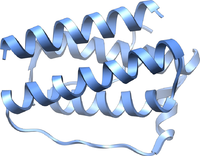
Photo from wikipedia
OBJECTIVES: The purpose of this study was to describe selected sacral tissue characteristics in a convenience sample of healthy volunteer subjects. DESIGN: Descriptive. SAMPLE AND SETTING: Fifty healthy volunteers in… Click to show full abstract
OBJECTIVES: The purpose of this study was to describe selected sacral tissue characteristics in a convenience sample of healthy volunteer subjects. DESIGN: Descriptive. SAMPLE AND SETTING: Fifty healthy volunteers in a clinical learning center in a school of nursing. METHODS: Sacral scans were obtained using a 20-MHz ultrasound scanning system in 3 positions: prone and 60° and 90° side-lying from the back. The images were analyzed by software in the ultrasound program using quantitative parameters of dermal thickness and density (dermal median intensity and derived number of low-echogenic pixels to total pixels [LEP:TP] ratio). RESULTS: In general, average values were as follows: dermal thickness between 2.32 and 2.65 mm; median pixel intensity between 102 and 112; and the LEP:TP ratio between 0.39 and 0.56. There were significant differences in sacral tissue characteristics between measures of thickness and dermal density (median intensity and LEP:TP ratio) by subject side-lying position (60° and 90°) versus prone position, with all P values less than .0001. CONCLUSIONS: Overall, the ranges were consistent across measures of thickness and dermal density except for systematic differences between side-lying and prone positions. When comparing thickness, median intensity, or LEP:TP ratio, it is important to report subject position. To best recognize tissue inflammation indicative of pressure injuries before surface changes are seen, it is useful to understand healthy high-frequency ultrasound sacral tissue characteristics. It is anticipated that quantitative assessment of dermal thickness, density, and LEP:TP ratio could help identify individuals with incipient pressure injury.
Journal Title: Journal of Wound, Ostomy and Continence Nursing
Year Published: 2017
Link to full text (if available)
Share on Social Media: Sign Up to like & get
recommendations!